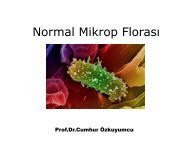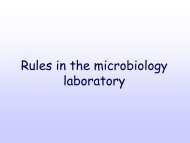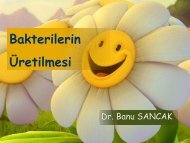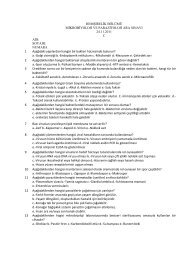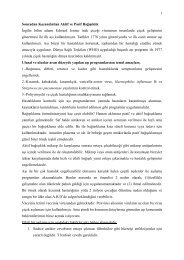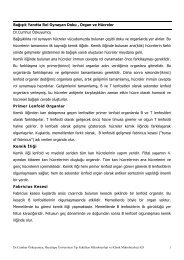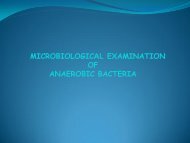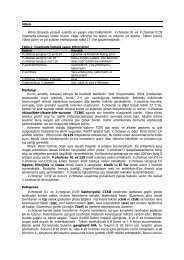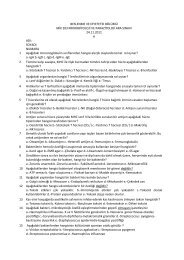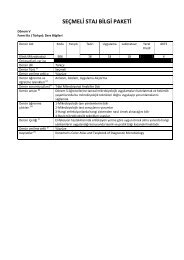NORMAL MICROBIAL FLORA
NORMAL MICROBIAL FLORA
NORMAL MICROBIAL FLORA
Create successful ePaper yourself
Turn your PDF publications into a flip-book with our unique Google optimized e-Paper software.
water breaks and the birth process begins, so does colonization of the body surfaces.<br />
Handling and feeding of the infant after birth leads to establishment of a stable<br />
normal flora on the skin, oral cavity and intestinal tract in about 48 hours.<br />
Resident flora: Consist of relatively fixed types of microorganisms regularly found in<br />
a given area at a given age. Resident flora promptly reestablishes itself if disturbed.<br />
Transient flora: Consist of non-pathogenic or potentially pathogenic microorganisms<br />
that inhabit the mucous membranes for hours, days, weeks. Members of the transient<br />
flora are derived from the environment and they are not establish themselves<br />
permenantly on the surfaces. They can not cause infectious diseases if resident flora<br />
remains intact.<br />
Normal flora of the skin:<br />
Several factors such as dryness, low pH, inhibitory substances (lysozyme from sweat<br />
glands and toxic fatty acids from sebaceous glands) are responsible for discouraging<br />
skin colonization. Staphylococcus species do compose 90% of aerobic members of<br />
normal skin flora. Anaerobic diphteroids inhabit deeper layers of skin.<br />
Normal flora of respiratory tract:<br />
Mouth: Continous flow of saliva exerts a mechanical flushing action that removes<br />
many microorganisms. Until eruption of teeth, most microorganisms in oral cavity are<br />
aerobes and facultative anaerobes. As the first tooth appears, obligate anaerobes<br />
become more evident as the tissue surrounding the teeth provides an anaerobic<br />
environment. Streptococcus mutans is a member of normal oral flora and appears to<br />
be the major ethiological agent of dental caries.<br />
Upper respiratory tract: Through inhalation, air containing microorganisms pass<br />
through nasal passages and nasopharynx, microorganisms stick to the thin moisty<br />
layer of highly viscous mucus that overlies these surfaces. Mucus also contains<br />
bactericidal enzyme, lysozyme. In additon, rythmic beating of ciliar epithelial cells of<br />
upper respiratory tract drives microorganisms through pharynx. Nose and<br />
nasopharynx are inhabited by many microorganisms despite those mechanisms.<br />
A large number of bacterial species colonize upper respiratory tract (nasopharynx).<br />
Nostrils are always heavily colonized, predominantly with Staphylococcus<br />
epidermidis and Corynebacteria, and often (in about 20% of the general population)<br />
with Staphylococcus aureus, this being the main carrier site of this important<br />
pathogen.<br />
Staphylococci are the main habitants of the nose. Other normal flora members of<br />
nasopharynx are to be Streptococcus, Neisseria and Haemophilus species.<br />
Lower respiratory tract: Trachea and bronchi do not have a normal flora due to ciliadriven<br />
mucus flow. The lower respiratory tract (trachea, bronchi and pulmonary<br />
tissues) is virtually free of microorganisms, mainly because of the efficient cleansing<br />
action of the ciliated epithelium which lines the tract. Any bacteria reaching the lower<br />
2



